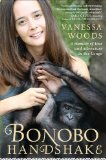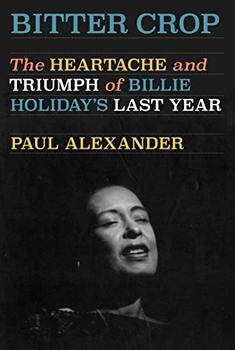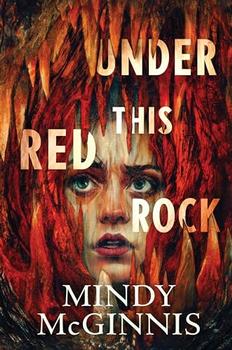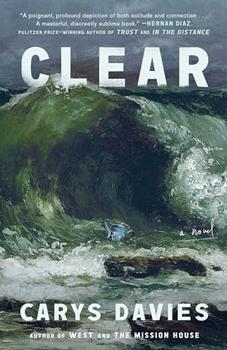Summary | Excerpt | Reading Guide | Reviews | Beyond the Book | Read-Alikes | Genres & Themes | Author Bio

Critics' Opinion:
Readers' Opinion:
First Published:
May 2010, 278 pages
Paperback:
Jun 2011, 288 pages
 Book Reviewed by:
Book Reviewed by:
Kim Kovacs
Buy This Book
This article relates to Bonobo Handshake
Vanessa Woods with bonobos in a wildlife sanctuary
in the Democratic Republic of Congo.
Sydney Morning Herald
Bonobos (Pan paniscus) are one of the two species that make up the genus Pan,
along with Pan troglodytes, the Common Chimpanzee. Chimps and bonobos are the
closest extant relative to humans, sharing almost 99% of our DNA. They are also
the least known of the great apes (which in addition to bonobos includes chimpanzees,
orangutans, and gorillas), and remained unidentified as a separate species until
1933.
Bonobos are sometimes referred to as pygmy chimpanzees, but this is a misnomer, as on average they weigh the same or only slightly less than common chimpanzees (approximately 85 pounds for males and 68 pounds for females). Their bodies are proportioned quite differently, with a lower center of gravity, longer limbs, and a smaller head. The difference in their anatomy allows them to stand more erect than chimps, walking upright up to 25% of the time. When they move on all fours they walk on their palms as opposed to on their knuckles the way the chimpanzees do.
 Bonobos also differ from chimps in that the hair on their head parts in the middle, they have pink lips, and a less heavy brow over their eyes (giving their features a more human look).
Bonobos also differ from chimps in that the hair on their head parts in the middle, they have pink lips, and a less heavy brow over their eyes (giving their features a more human look).
A very small region of the Democratic Republic of the Congo, south of the Congo River is the only area where bonobos live in the wild - just 77,000 square miles of habitat. They're much less adaptable than chimpanzees, requiring high rainforest canopy, and spend much more time in the trees than other African apes. Bonobos eat mostly fruit, but will also eat grubs, small crustaceans and leaves.
One of the most interesting aspects of bonobos is their unique social structure.
Unlike other apes, the males are not dominant. While males individually are
heavier and stronger than females, the females have a strong hierarchy and often
unite to dominate the community. The males are tolerant of juveniles and infants,
and court females (as opposed to forcing their attentions on them, as is the
norm with other apes). In comparison with other apes, they exhibit a low level
of aggression between individuals and other groups of bonobos. Most conflicts
within groups are eased by grooming, sharing food, or sexual activity.
Bonobos are highly sexual, using sexual activity as a greeting, to settle conflict or defuse tension (the phrase "make love not war" is often associated with these animals). Bonobos are the only non-human animals that have been observed engaging in tongue kissing and oral sex. They are also the only apes that engage in sexual activity even when the female is not fertile. Homosexual pairings are not uncommon.
Due to habitat loss and human hunting, bonobos are an endangered species. It
is widely estimated that fewer than 10,000 exist in the wild, with some putting
the figure as low as 5,400. The fact that their only habitat is in the middle
of a single, war-torn country is seen as further jeopardizing conservation efforts.
Lola ya Bonobo is the world's only sanctuary for orphaned bonobos.
Filed under Nature and the Environment
![]() This "beyond the book article" relates to Bonobo Handshake. It originally ran in August 2010 and has been updated for the
June 2011 paperback edition.
Go to magazine.
This "beyond the book article" relates to Bonobo Handshake. It originally ran in August 2010 and has been updated for the
June 2011 paperback edition.
Go to magazine.





The House on Biscayne Bay
by Chanel Cleeton
As death stalks a gothic mansion in Miami, the lives of two women intertwine as the past and present collide.

The Flower Sisters
by Michelle Collins Anderson
From the new Fannie Flagg of the Ozarks, a richly-woven story of family, forgiveness, and reinvention.

The Funeral Cryer by Wenyan Lu
Debut novelist Wenyan Lu brings us this witty yet profound story about one woman's midlife reawakening in contemporary rural China.
Your guide toexceptional books
BookBrowse seeks out and recommends the best in contemporary fiction and nonfiction—books that not only engage and entertain but also deepen our understanding of ourselves and the world around us.